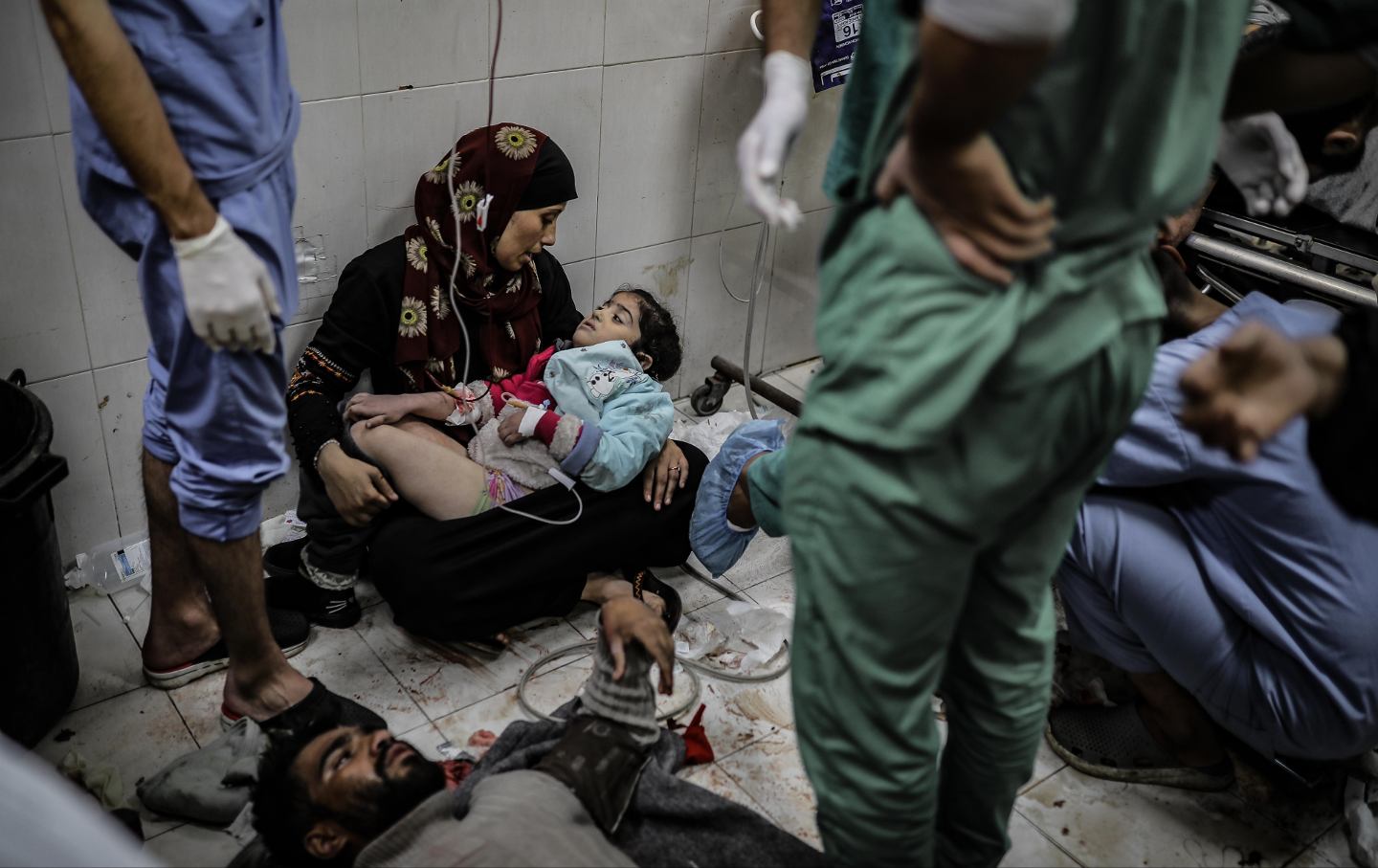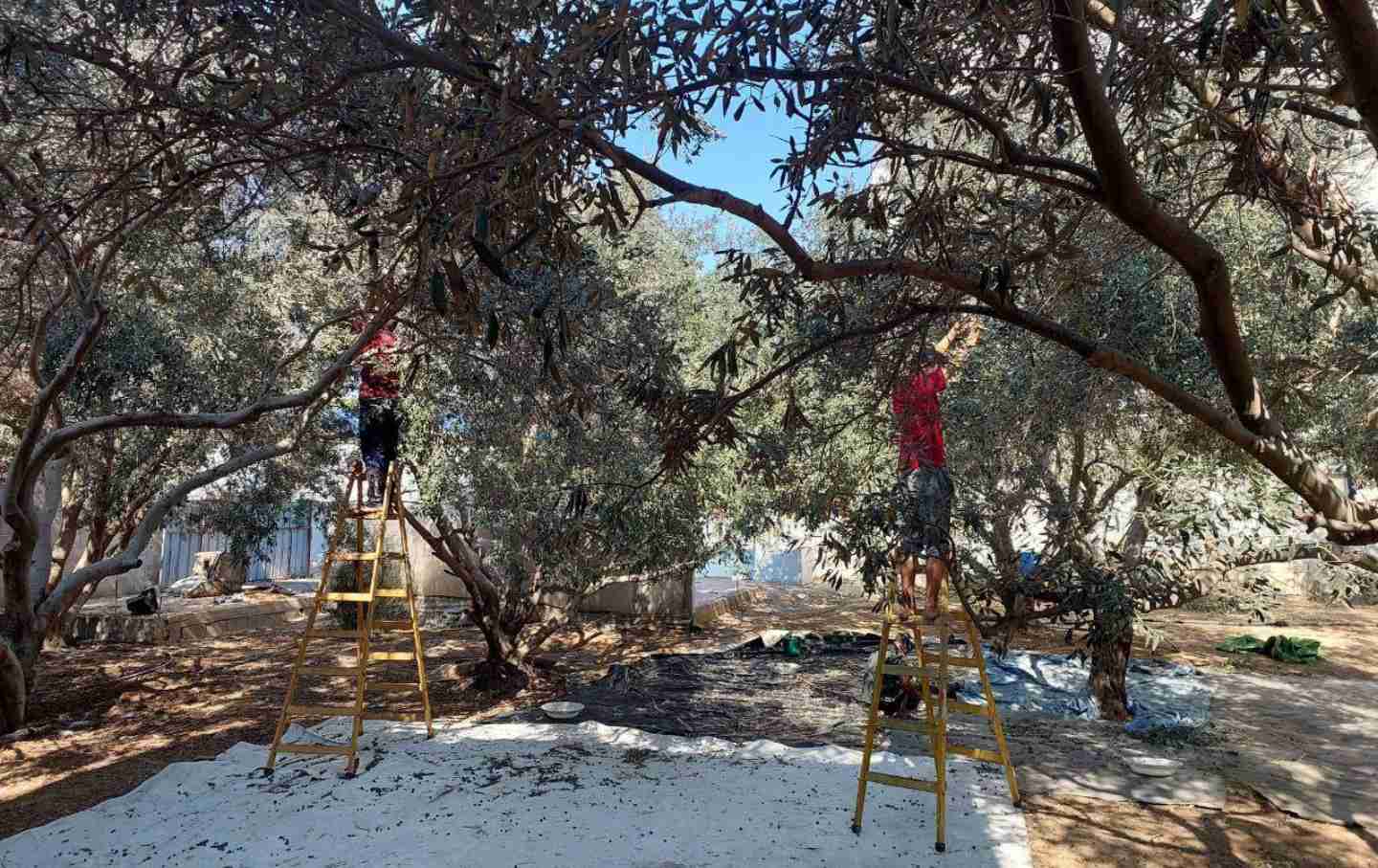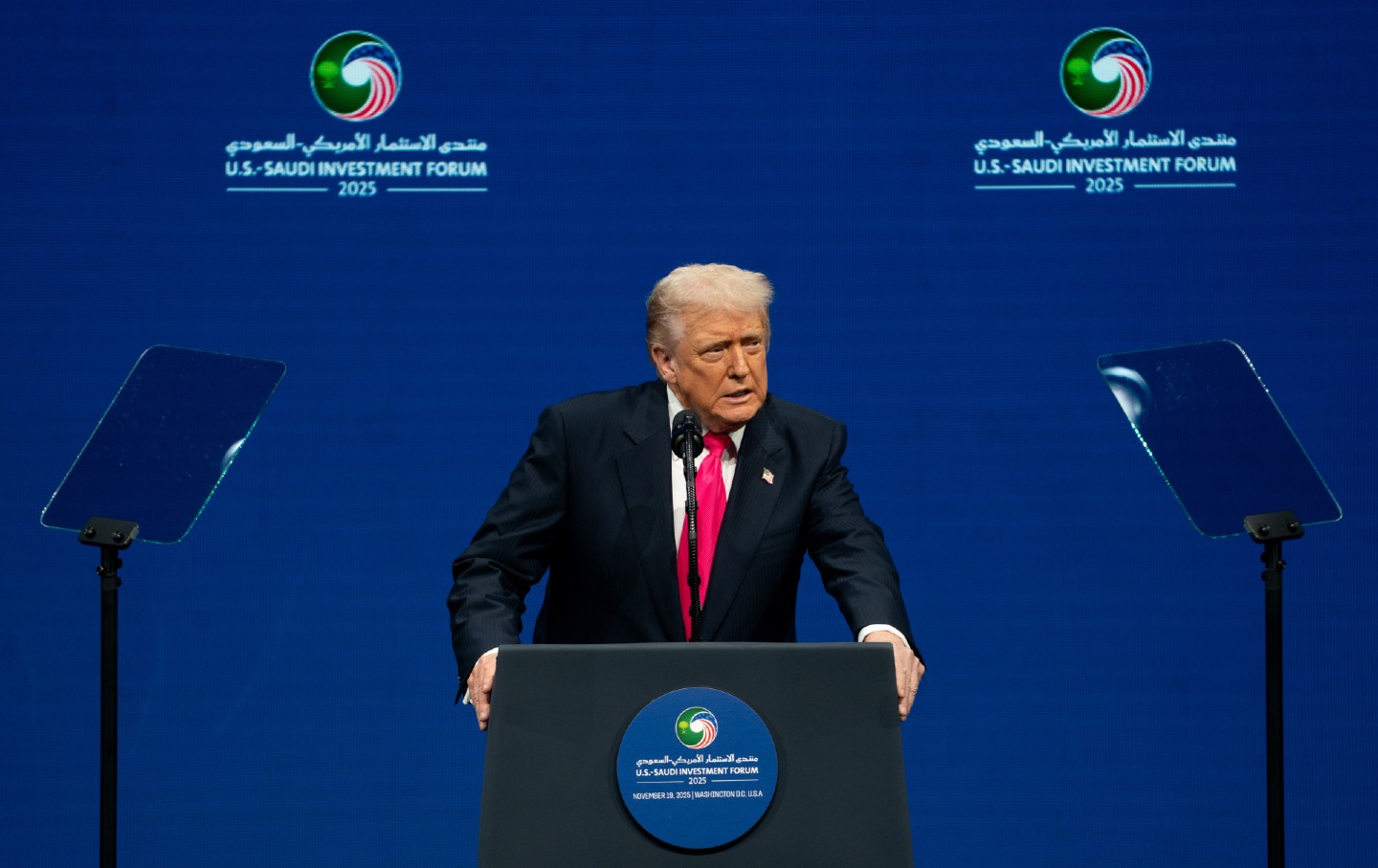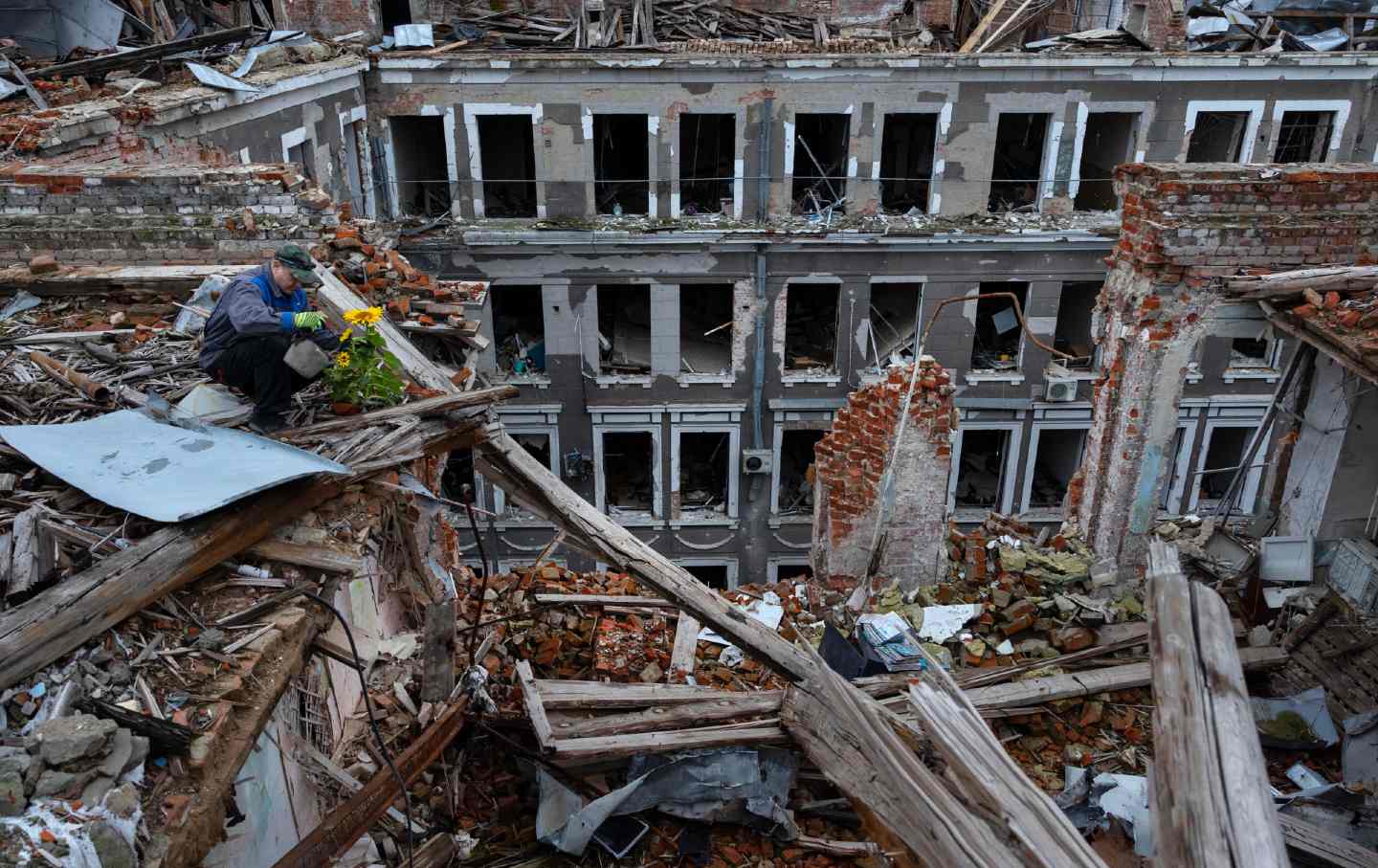Israel Has Created a Medical Apocalypse in Gaza
The hospital system is barely functional. Disease is running rampant. Medical workers are being kidnapped, tortured, and killed. And the world is letting it happen.

Injured Palestinians, including children, are brought to Nasser Hospital to receive medical treatment following Israeli attacks in Khan Yunis, Gaza, on January 22, 2024.
(Belal Khaled / Anadolu via Getty Images)Before October 2023, I was under the naïve impression that medicine was something like a universally sacred institution during wartime. I thought that the explicit targeting of medical infrastructure would not be tolerated or would, at least, be unequivocally condemned.
I had come to expect this based on a general pattern I’d observed. An American gunship attack against a Médecins Sans Frontières trauma hospital in Kunduz, Afghanistan, in 2015, which killed 42 people, was denounced by MSF and other international actors. When the United States apologized and called it a “mistake,” the MSF president expressed her doubts, insisting the organization “need[ed] to know what happened and why it led to an airstrike on a hospital which has been known in the region for the last four years, which has been treating thousands of people,” and whose coordinates the US military had been provided. Western media outlets covered, to some extent, this inconvenient rebuttal.
In 2022, Russia attacked a children’s hospital and maternity ward in Mariupol, Ukraine, killing three people. The bombing made news headlines for days. Journalists flatly accepted the idea that the strike was deliberate in advance of any independent investigation, because, frankly, why else would you bomb a hospital? NPR, for instance, reported that “the World Health Organization (WHO) decried the Russian airstrike that devastated [the medical complex].” Verbs like “decry” and “devastate” capture the appropriate reflexive response to assaults on healthcare.
Yet for the past four months in Gaza we have witnessed an attempt to dull this response. Israel’s assault on medical infrastructure amounts to one of the few discernible military objectives of this war. This makes sense, as medicine’s commitment to life compromises the effective implementation of genocidal intent.
According to a WHO report from January 30, 2024, only 13 of 36 hospitals in Gaza remain partially functioning. (There are around 6,120 hospitals in the United States. Per a crude calculation—ignoring the incredible variability in what counts as “partially functioning”—this is the equivalent of 4,080 American hospitals being damaged or destroyed.) The same report said that 13 of 77 primary healthcare facilities are operational and that 342 attacks on healthcare infrastructure have been reported, although the actual number is likely much higher, as reporting from northern Gaza is increasingly limited.
Six hundred and twenty-seven healthcare workers have been killed by Israeli forces so far, according to the WHO. Forty-seven ambulances have been damaged or destroyed through direct targeting, often while bringing victims of the most recent Israeli air strike to the hospital. Women in active labor sometimes rely on donkeys for transport to medical facilities, although even these animals are not safe from targeting.
This devastated infrastructure is meant to cope with one of the worst humanitarian crises of modern times. On October 9, Israeli Defense Minister Yoav Gallant infamously ordered a “complete siege” of Gaza, adding, “There will be no electricity, no food, no fuel, everything is closed.” As a result, 95 percent of the 600,000 people facing starvation around the world right now are in Gaza, according to the UN. Communicable diseases are rampant due to the measured annihilation of Gaza’s civilian infrastructure, including the most basic means of sanitation and the concentration of millions of people into ever-dwindling pockets of land. (Impossibly here, I’m asking the reader to ignore the trauma and the bombs, and instead focus on epidemics, whose spread at least one retired Israeli general has lauded as a crucial tool of battle.)
In late December, the WHO reported that there was one toilet for every 480 persons in Gaza. Eight thousand new cases of hepatitis A and almost 45,000 new skin rashes have been reported, along with tens of thousands of new respiratory infections and 165,000 new cases of diarrheal infections, including more than 85,000 cases in children less than 5 years old.
Today, because of the Israeli prohibition on diagnostic tools and, more importantly, the prevention of safe access to hospitals, many infectious diseases can’t be formally diagnosed. If people can reach a healthcare facility at all, there is often no available treatment, even for things like cholera (which causes profuse watery diarrhea) whose treatment is fairly simple: rehydration.
Many Gazan hospitals are running out of IV fluids, the most basic essential in a doctor’s resuscitative tool kit. Even if someone were to attempt oral rehydration in Gaza, they’d likely struggle, as Israel is limiting the entry of water into Gaza to around a liter per person (this includes water for showering, cooking, etc.; the WHO recommends a minimum of 15 L per person per day, although 300 L is closer to what the average American consumes daily). Gaza’s three desalination plants were targeted by Israel early in the war, and, even before October, 97 percent of the tap water in Gaza wasn’t fit for consumption.
This is by no means a comprehensive list of the medical horrors in Gaza. For interested readers, the WHO has been publishing this data since the start of the assault against Gaza, with recommendations included at the end of each document. On October 8, the first recommended intervention read, “immediate end to hostilities.” On January 30, “immediate cease-fire.”
The aftermath of the bombing of Al-Ahli Hospital on October 17 served as a point of rupture and a litmus test. I was surprised to see Western media outlets condemning what appeared to be an Israeli attack, even before an on-the-ground investigation (which Israel refused to accommodate) could be carried out. The final death toll settled at 471 people—a massacre at a hospital. I wondered, warily, if this might finally be the turning point.
In the immediate wake of the attack, Palestinian doctors held a press conference outside the hospital, where they’d just been treating patients. They stood surrounded by a sea of dead bodies covered in colorful winter blankets, to try to preserve the victims’ dignity without minimizing the viewer’s ability to take in the enormity of the crime.
Then came the retractions, the edits from “attack” to “explosion” and the suggestion this was likely an aberrant Palestinian missile. The Israeli military produced an audio clip it claimed to have intercepted from Palestinian militants, which was easily exposed as fake. News outlets and human rights groups conducted investigations, many of which came to dramatically different conclusions about what had happened and who was responsible. The news cycle moved on.
The story faded into the background. But the initial condemnation of the attack was also an invitation for people to push for meaningful consequences in instances where no doubt could be instilled about Israel’s responsibility.
Yet after Al-Ahli came attack after attack on hospital after hospital, with the responsible party never in question. Israel has been brazen in its flouting of international law and steadfast in its commitment to cut off Gaza’s lifelines. And it has done this largely with impunity. Western media coverage (or lack thereof) of these attacks has exposed what would be tolerated, as well as how these horrific means could be spun and diffused in service of an end like ethnic cleansing or genocide. A typical New York Times headline from February 12 read, “A Tunnel Offers Clues to How Hamas Uses Gaza’s Hospitals.” An entirely different precedent had been set: that when Israel bombs hospitals, it’s not such an obvious crime after all.
Israeli attacks against “enemy” hospitals date back at least to the siege of Beirut in 1982. In previous assaults against Gaza, Israel often targeted doctors in their sleep, by collapsing a lethal mass of concrete—usually in the form of a multigenerational home—atop the doctor and tens of their family members. The difference now is a matter of magnitude and perhaps the myopic urgency of revenge. The end goal is consistent with the Nakba, although the means and methodologies have evolved considerably.
In the last four months, maternity wards and operating rooms have been sniped into, children’s hospitals have been rained on with white phosphorus, and pediatric cancer centers have been bombed and evacuated. Hospital solar panels have been targeted to safeguard the intended effects of barring fuel from entering Gaza. The WHO declared Gaza’s largest medical complex, Al-Shifa Hospital, “nearly a cemetery” in early November, as doctors helped dig mass graves in the hospital complex courtyard, and tanks and troops closed in on the premises. And while this phrase, “nearly a cemetery,” was picked up and circulated across American media, journalists also regurgitated US and Israeli propaganda that these were terrorists’ nests.
Popular
“swipe left below to view more authors”Swipe →Meanwhile, at Al-Shifa, Kamal Adwan, Al-Awda, and elsewhere, doctors, especially those with specialty training, have been rounded up and taken to undisclosed locations and interrogated, tortured, and/or disappeared. As of January, at least 61 healthcare workers, including hospital directors, had been arrested by Israeli forces in Gaza. At the time of this writing, the whereabouts of the medical directors of the three hospitals listed above (named, respectively, Dr. Abu Salamiya, Dr. Al-Kahlot, and Dr. Muhanna) remain unknown, weeks after they were abducted while treating patients.
In a video from early February, Dr. Said Ma’arouf, a pediatrician who was taken hostage while working at Al-Ahli Hospital, testified to various modes of torture, his tired face suggesting there were certain indignities he wouldn’t disclose. He said he was blindfolded with his legs tied up for 45 days. He now suffered from paresthesias in his hands and had trouble standing. He had lost more than 50 pounds. Still, immediately upon his release, he returned to the hospital to care for his patients, despite the risks he knew all too well. In the video, Ma’arouf’s eyes welled as he shared that he didn’t know where his wife and five children are.
The attacks go on and on, endlessly. On February 13, one day after the aforementioned Times headline implicitly justified Israel’s sustained attacks on Palestinian hospitals, a video circulated on social media. It showed a Palestinian hostage addressing internally displaced people seeking shelter at Al-Nasser Hospital—the major hospital in Khan Younis and, as of then, the largest still-functioning hospital in all of Gaza. The man had been sent by his Israeli captors to say that Al-Nasser was next. Another video circulated hours later, of the man in a body bag. He had been sniped before leaving the hospital gates, after serving his purpose.
Outside Al-Nasser hospital around this time, a message blared from an Israeli bulldozer, “Get out, ya hayawanaat,”—you animals. Dr. Haitham Ahmad, an emergency medicine physician stationed there, stressed, “We’re living through fear and anxiety amid attempts to evacuate the people sheltering in the hospital. Many civilians have been shot by snipers, most of them within the hospital parameters.” Ahmad and other physicians were taken hostage by the Israeli forces when they raided Al-Nasser. Several patients were killed. Dr. Israa Abu Rogaa, leading a group of evacuees to Rafah, was targeted by a drone and severely wounded. No explanations were given; none, by legacy media, were asked of Israel. The WHO now says that Al-Nasser is no longer functional.
While international attention focuses on Gaza, Israeli military campaigns against medical infrastructure in the West Bank are expanding, too. Israeli forces raided Ibn Sina Hospital in Jenin on 30 January 2024, disguising themselves as doctors, nurses, and patients to enter and assassinate a partially paralyzed patient and his visitors, all in their sleep. (Israel said, predictably, that it was hunting for terrorists.)
Dr. Tawfiq Shawbaki, the head of Ibn Sina’s surgery department, said the raid was most concerning in that it set yet another dangerous precedent. In the past, the Israelis had targeted ambulances in the West Bank, blocked patients from reaching the hospital, or besieged people inside of them. They had also entered hospitals in military uniform, and even disguised themselves as patients, to make arrests. Disguising themselves as medical staff to kill people, though—that was new.
As the fighting between Lebanon and Israel escalates from low- to moderate-intensity warfare, Gallant has threatened Lebanese civilians that “what we can do in Gaza, we can do in Beirut.” Among the things Israel has shown it does remarkably well is target medical infrastructure. If nothing changes, it is not unreasonable to understand Gallant’s threats to include the leveling of Beirut’s hospitals and the targeting of Lebanese medical staff in a potential future war. Dr. Ghassan Abu-Sittah, a British-Palestinian plastic and reconstructive surgeon who volunteered in Gaza at the beginning of the Israeli assault, has said that the next war, not just in Gaza, or even the Middle East, will begin where this one ends.
The attacks against Palestinian medical infrastructure are not “shocking” anymore, if we measure shock as proportional to mainstream media indignation. In describing the targeting of Gaza’s medical infrastructure and personnel, media outlets usually refrain from considering the possibility, as they know to do with Russian airstrikes, that these are attacks against hospitals and ambulances and doctors as such—that the pretext of a “hunt for Hamas” is simply that. It is obvious enough for those who are willing to see; for instance, Israeli attacks against the health infrastructure in Gaza are sufficiently systematic to feature prominently as evidence for plausible genocide in South Africa’s case before the International Court of Justice.
A dangerous precedent has been set that doesn’t bode well for the future of modern warfare, especially in service of empire.
A turning point becomes a precedent if, instead of pivoting, we continue on. We find ourselves in a new world, one that is infinitely more cruel. What are the red lines? When will we say “enough”? Or rather, what can we do differently so that the definition of “never again” is out of the hands of the people who insist on yet again, only worse?
A Palestinian psychiatrist in Gaza, Dr. Mustafa El-Masri, tweeted on February 6,
This may sound repetitive, but I hope you never get used to it: The [Israeli] assault on medical facilities persists. Forced evacuation of Al-Amal Hospital in Khanyounis [sic]. Some doctors could not leave and you know what will come next.
I hope you never get used to it.
Disobey authoritarians, support The Nation
Over the past year you’ve read Nation writers like Elie Mystal, Kaveh Akbar, John Nichols, Joan Walsh, Bryce Covert, Dave Zirin, Jeet Heer, Michael T. Klare, Katha Pollitt, Amy Littlefield, Gregg Gonsalves, and Sasha Abramsky take on the Trump family’s corruption, set the record straight about Robert F. Kennedy Jr.’s catastrophic Make America Healthy Again movement, survey the fallout and human cost of the DOGE wrecking ball, anticipate the Supreme Court’s dangerous antidemocratic rulings, and amplify successful tactics of resistance on the streets and in Congress.
We publish these stories because when members of our communities are being abducted, household debt is climbing, and AI data centers are causing water and electricity shortages, we have a duty as journalists to do all we can to inform the public.
In 2026, our aim is to do more than ever before—but we need your support to make that happen.
Through December 31, a generous donor will match all donations up to $75,000. That means that your contribution will be doubled, dollar for dollar. If we hit the full match, we’ll be starting 2026 with $150,000 to invest in the stories that impact real people’s lives—the kinds of stories that billionaire-owned, corporate-backed outlets aren’t covering.
With your support, our team will publish major stories that the president and his allies won’t want you to read. We’ll cover the emerging military-tech industrial complex and matters of war, peace, and surveillance, as well as the affordability crisis, hunger, housing, healthcare, the environment, attacks on reproductive rights, and much more. At the same time, we’ll imagine alternatives to Trumpian rule and uplift efforts to create a better world, here and now.
While your gift has twice the impact, I’m asking you to support The Nation with a donation today. You’ll empower the journalists, editors, and fact-checkers best equipped to hold this authoritarian administration to account.
I hope you won’t miss this moment—donate to The Nation today.
Onward,
Katrina vanden Heuvel
Editor and publisher, The Nation
More from The Nation

The US Is Looking More Like Putin’s Russia Every Day The US Is Looking More Like Putin’s Russia Every Day
We may already be on a superhighway to the sort of class- and race-stratified autocracy that it took Russia so many years to become after the Soviet Union collapsed.

Israel Wants to Destroy My Family's Way of Life. We'll Never Give In. Israel Wants to Destroy My Family's Way of Life. We'll Never Give In.
My family's olive trees have stood in Gaza for decades. Despite genocide, drought, pollution, toxic mines, uprooting, bulldozing, and burning, they're still here—and so are we.

Trump’s National Security Strategy and the Big Con Trump’s National Security Strategy and the Big Con
Sense, nonsense, and lunacy.

Does Russian Feminism Have a Future? Does Russian Feminism Have a Future?
A Russian feminist reflects on Julia Ioffe’s history of modern Russia.

Ukraine’s War on Its Unions Ukraine’s War on Its Unions
Since the start of the war, the Ukrainian government has been cracking down harder on unions and workers’ rights. But slowly, the public mood is shifting.

I’m a Teacher in Gaza. My Students Are Barely Hanging On. I’m a Teacher in Gaza. My Students Are Barely Hanging On.
Between grief, trauma, and years spent away from school, the children I teach are facing enormous challenges.


